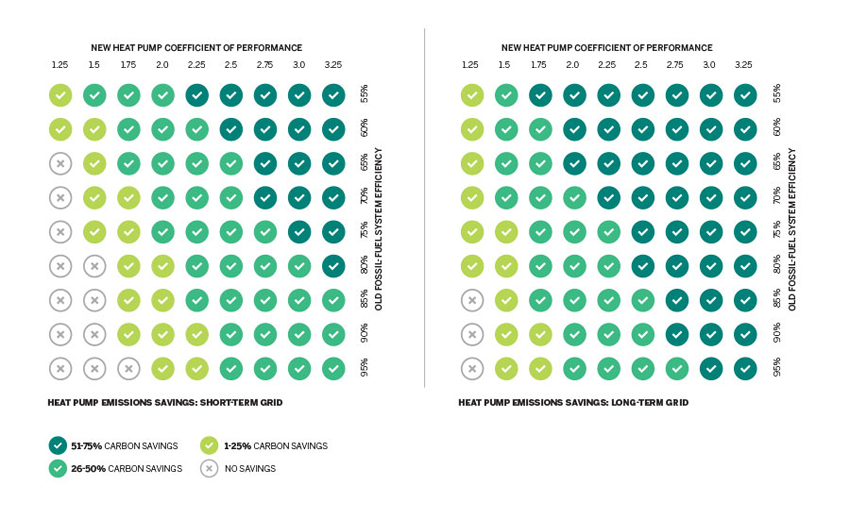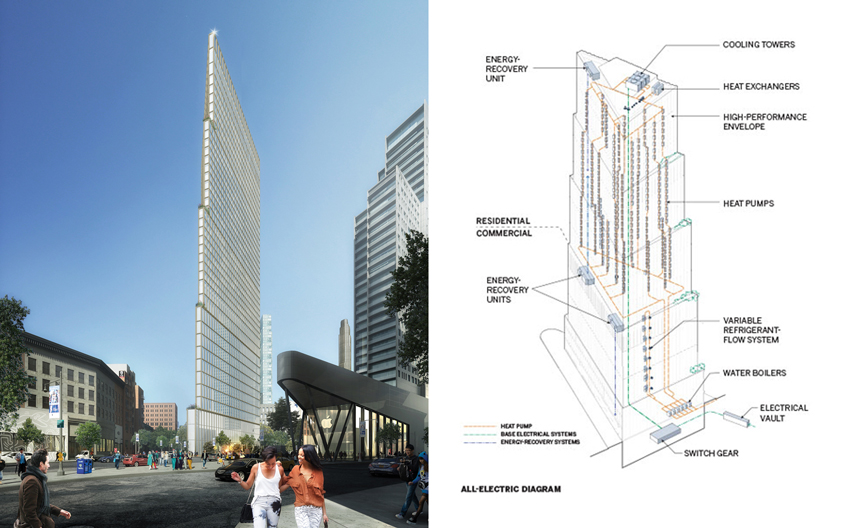Building Electrification
A confluence of developments is making all-electric buildings a powerful strategy to help alleviate the climate crisis. The most consequential is the transition toward a cleaner grid. In 2019, approximately 38 percent of the country’s electricity was generated from non-fossil-fuel sources, including nuclear, wind, hydropower, and solar, up from about 30 percent two decades ago, according to the U.S. Energy Information Administration. The proportion of electricity generated from, in particular, wind, solar, and biomass is rapidly expanding. According to Headwaters Economics, a nonprofit research group, between 2012 and 2020, 891,383 megawatts (mW) of new generation capacity from these sources was added to the grid, while only 35,302 mW of natural gas capacity was added. At the same time, coal-fired power plants are being retired, notes Mike Henchen, a principal on the carbon-free buildings team at the Rocky Mountain Institute (RMI), a research and consulting organization focused on resource efficiency. “The grid has gotten cleaner faster than many people realize,” he says.

RETROFITTING New York’s multifamily buildings to electric space- and water-heating would achieve carbon savings now (left), according to the Urban Green Council. The savings would be enhanced as more renewable capacity is added to the grid (above).

IMAGES: COURTESY URBAN GREEN COUNCIL (TOP); ALLOY (BOTTOM)
A 40-STORY TOWER planned for downtown Brooklyn will have all-electric systems, including those for cooking. Its designer and developer, Alloy, is betting that this strategy will provide a market advantage.
Sources say electrification makes good climate sense even before the grid is entirely fossil-fuel-free. For instance, the Urban Green Council, a New York–based sustainable-building nonprofit, has studied the carbon implications of retrofitting the city’s multifamily buildings with all-electric space-heating and hot-water systems. Currently, oil- and gas-burning equipment in residential buildings accounts for 40 percent of New York’s overall carbon emissions, says John Mandyck, the council’s CEO. The analysis modeled the new systems and those they would replace at various levels of efficiency, and took into account the evolving nature of the electrical grid. For nearly all scenarios, it determined there would be carbon benefits to making the switch in the near term, even though two-thirds of the city’s electricity is currently generated by burning oil and natural gas, and despite the fact that its power supply will become even more carbon-intensive with the shutdown of an aging nuclear power plant in nearby Westchester County slated for 2021. Urban Green predicts emissions reductions will be even greater from such retrofits once renewable generation capacity is added to the electrical grid in 2030 and beyond.
In addition to a cleaner grid, technological advances are propelling the electrification movement forward. Improved equipment for space heating and hot water are making the transition practical: the game-changer is the greater efficiency of heat pumps, devices similar to air conditioners, but that provide heating as well as cooling. With the help of refrigerants, compressors, and the second law of thermodynamics, air-source heat pumps (the most common type) pull heat from outside and transfer it indoors in the winter, and, in the warmer months, they extract heat from the indoor air and release it outside. Although the technology isn’t new, the latest generation of these machines, unlike earlier ones, work when temperatures dip well below freezing, making them a legitimate space-heating option for colder regions of the country. They are more efficient than their fossil-fuel burning counterparts, since they transfer more thermal energy than they consume.
Innovations in electric kitchen appliances, namely the induction stove top, are also making the transition practical. While consumers have been slow to embrace the technology due to “cultural barriers,” says Panama Bartholomy, director of the electrification-advocacy group Building Decarbonization Coalition, he and others tout the benefits of all-electric cooking, including improved indoor air quality (gas ranges and ovens emit toxic gases such as nitrogen dioxide and carbon monoxide); efficiency; and a cooler kitchen.
Some housing developers are betting the public will come around. A 40-story all-electric building slated to break ground in downtown Brooklyn next year will be New York’s first all-electric residential tower, according to Alloy, its architect and developer. AJ Pires, the company’s president, cites a number of factors in switching from burning fossil-fuel energy on-site, including the difficulty of coordinating underground infrastructure in a dense urban environment, near a major subway and commuter-rail hub, and the requirements of New York’s Local Law 97, the 2019 legislation that set tough limits on the amount of carbon that buildings can emit. Pires believes that electric boilers for hot water, heat pumps for space-heating, an energy-recovery system, and the induction cooktops will appeal to prospective tenants: “We think the appliances will provide a market advantage,” he says.
Beyond climate benefits and the health and comfort of occupants, analyses show that going electric often can save money. A recent RMI study compared the cost of building and operating a new all-electric single-family house to that of one relying on gas for cooking, space-heating, and water-heating in seven U.S. cities: Austin, Texas; Boston; Seattle; Columbus, Ohio: Denver; Minneapolis; and New York. Some findings were surprising, says RMI’s Henchen. Though up-front costs for the mixed-fuel house were higher in most of the cities analyzed, in Minneapolis—which was the coldest climate considered and required the most expensive heat pump—the cost of building the two options was roughly equivalent. However, operating costs for the non-gas house were 9 percent lower, due to a special winter electric-heating rate offered by the local utility. The analysis of Boston, meanwhile, revealed higher annual utility rates for all-electric, but these were outweighed by savings in up-front costs. All of the cities showed considerable carbon savings for the electric-only scenario, especially Seattle, where greenhouse-gas emissions with all-electric over the next 15 years would be a stunning 93 percent lower.









